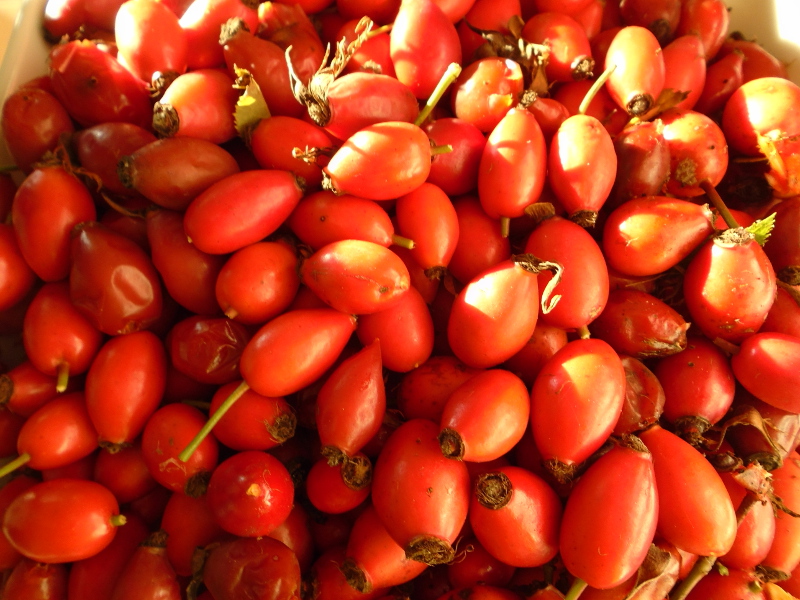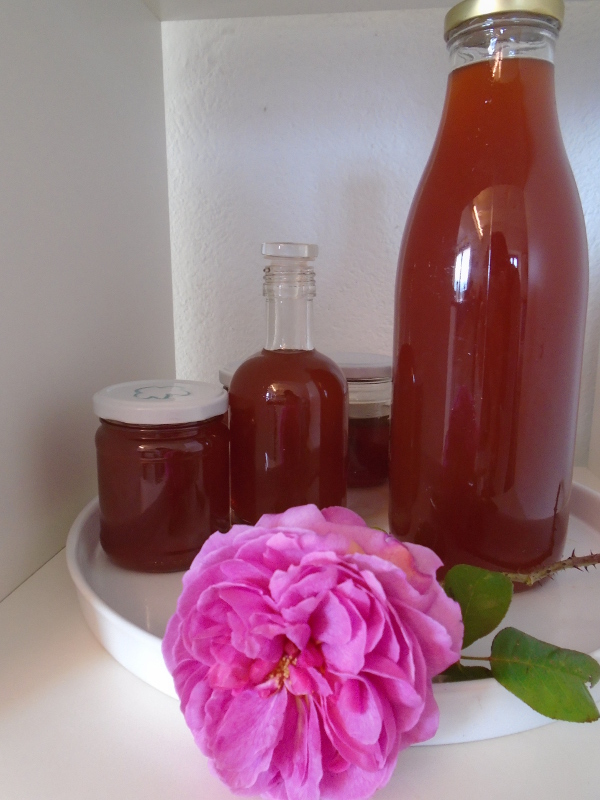Making rose hip syrup
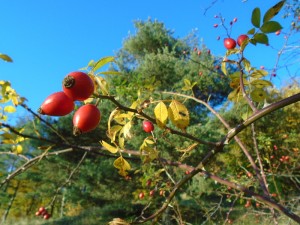 Typical. I went to a huge amount of effort to forage (ie loot) rose hips by the side of the road on the way to town, only to find most of my crop on my doorstep.
Typical. I went to a huge amount of effort to forage (ie loot) rose hips by the side of the road on the way to town, only to find most of my crop on my doorstep.
I was reading a new book – Brew it Yourself – and saw a recipe for rose hip syrup. With cider. I haven’t quite advanced to the stage of cider making, but I thought I could have a go with the hips.
And it’s funny but every time I turn out of our drive onto the road, I could see a waving bush full of bright red rose hips.
Up on the bank, admittedly. A scramble to reach them. But I thought it 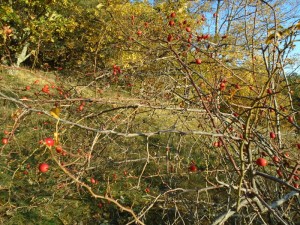 might be fun to start there. So out of the car (no traffic to worry about, even though it’s a single lane road) and up the bank with my plastic bag, I collected my first teensy batch. And my first bramble scratches.
might be fun to start there. So out of the car (no traffic to worry about, even though it’s a single lane road) and up the bank with my plastic bag, I collected my first teensy batch. And my first bramble scratches.
Oh yes, you forage at your peril among the wild roses around here.
I drove more slowly than normal all the way to town. And spotted two likely bushes en route.
But twas a palty raid really. Not enough to make so much as a tipple.
And I looked pretty silly stopping my car and leaping about the hedgerows hunting for little red orbs.
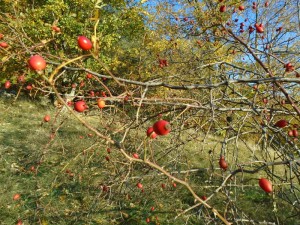 One elderly couple in a car slowed down while I was in the middle of a rose bush. And I know what they were thinking, as I do it too. It goes something like this. Oh dear, has she broken down? Does she need help? And seeing that I was smiling and looking in no distress, one changes the question. What is her number plate? Which is code for – is she one of us (an Ardèchoise), or one of those pesky townies from down in the valley (the Drôme) looting our chestnuts? We have lots of wild chestnut trees growing right beside our rural roads. And it vexes us no end to have people come and glean chestnuts to sell. Our farmers need all the help we can get.
One elderly couple in a car slowed down while I was in the middle of a rose bush. And I know what they were thinking, as I do it too. It goes something like this. Oh dear, has she broken down? Does she need help? And seeing that I was smiling and looking in no distress, one changes the question. What is her number plate? Which is code for – is she one of us (an Ardèchoise), or one of those pesky townies from down in the valley (the Drôme) looting our chestnuts? We have lots of wild chestnut trees growing right beside our rural roads. And it vexes us no end to have people come and glean chestnuts to sell. Our farmers need all the help we can get.
But I passed the test because chestnut season is over, and they smiled as they beetled along. But I decided to hot foot it out of there and get home.
Surely there were wild roses in our own forest. I seem to recall trying to chop one monster back a few years ago on the top terrace.
So thank goodness for being tardy with my annual maintenance of this large part of the farm.
There, proudly swaying in the breeze was the motherlode of rose hips. I yelped with delight. And teetered up the steep bank with my flapping plastic bag.
A kilo. A whole kilo of fruit. Great.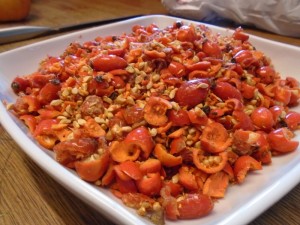
All I needed to do was check out all the recipes, both in the book and online. I like looking at the River Cottage recipes as they are accessible, not too bossy and usually simple.
I make a lot of syrup (cordial) here all year. Mainly using cherries, raspberries if I have enough, and my jostaberries. And I use a simple ratio: 600 grams of fruit to 300 grams of sugar to one litre of water. It works.
But all the recipes I looked at for rose hip syrup required a different process. You have to boil the hips, twice, in plenty of water to extract the juice. So the quantities are inexact. A bit vague. And I definitely think I added way too much sugar. And that was less than the amount everyone stipulated. But here goes for the recipe.
1 kilogram of rose hips
750 grams of castor (superfine) sugar
3 litres water
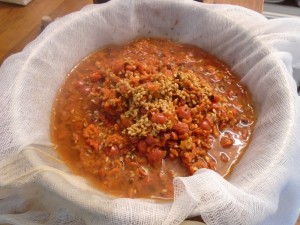 Wash the fruit (taking off all the stalks) and chop them in a food processor. You definitely don’t want to do this by hand. It’s messy. And the hairy seeds are the enemy.
Wash the fruit (taking off all the stalks) and chop them in a food processor. You definitely don’t want to do this by hand. It’s messy. And the hairy seeds are the enemy.
(Which is why in French they are called gratte-cul. Drop one of these rose hips down someone’s back and they will have an itchy bum. Charming, I know.)
Bring two litres of water to the boil, add the chopped hips, bring back to the boil, then turn off and leave the fruit to macerate for thirty minutes.
Strain the mixture into a bowl with a fine sieve, or a colander and cloths of muslin. You don’t want any of the hairy seeds to get into the liquid.
Set the strained liquid aside and return the pulp to the saucepan with another litre of water. Repeat the boiling and resting exercise. Strain this second batch into the liquid.
At this stage I measured my quantity of rose hip liquid. I had 2.2 litres. Wash the large saucepan and return this liquid back to the stove and bring back to the boil. Let it boil away until the quantity has reduced by a quarter. This is annoyingly vague in all the recipes. But after about five minutes of hard boiling, my liquid had reduced to 1.6 litres.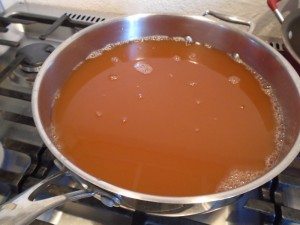
Turn the heat down to low and add in the sugar, stirring well to combine. Bring it back to the boil for a few minutes, ensuring all the sugar has dissolved.
Your syrup is ready. Pour into sterilized bottles or slosh into that awaiting glass of cider.
I must admit that I found the flavour a bit bland after such a zingy looking fruit. It doesn’t taste of roses. It’s more citrussy and sharp. So I held back some of the syrup and infused three scented pelargonium leaves for a few minutes under the hot liquid. Then removed the leaves and bottled it.
The result? A syrup with a bit more flavour, but baffling. If you asked someone to do a blind tast of this syrup I doubt they will be able to guess the origin. But I had fun making it. And will make sure I keep a beady eye on that rose bush from now on.
Tipple, anyone?
